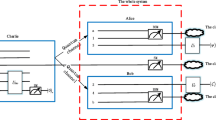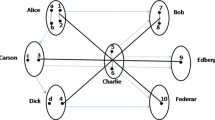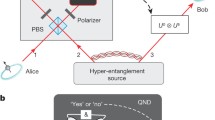Abstract
In this contribution, two versions of teleportation protocol are considered, based on either using a single or two copies of entangled atom-field state, respectively. It is shown that, by using the first version, the fidelity of the teleported state as well as the amount of quantum Fisher information, that contains in the teleported state, are much better than using the second version. In general, one may increases the fidelity of teleported information by increasing the mean photon number and decreasing the detuning parameter. The fidelity of teleporting classical information is much better than teleporting quantum information. Moreover, teleportating classical information that initially encoded in an exited states is much better than that encodes in the ground states. However, the teleported Fisher information that initially encoded in a ground state is much larger than those initially encoded in entangled states.










Similar content being viewed by others
References
Bennett, C.H., Brassard, G., Crepeau, C., Jozsa, R., Peres, A., Wootters, W.K.: Teleporting an unknown quantum state via dual classical and Einstein–Podolsky–Rosen channels. Phys. Rev. Lett. 70, 1895–1899 (1993)
Breuer, H.-P., Petruccione, F.: The Theory of Open Quantum Systems. Oxford University Press, Oxford (2007)
El Allati, A., Metwally, N., Hassouni, Y.: Transfer information remotely via noise entangled coherent channels. Opt. Commun. 284, 519–526 (2011)
El Allati, A., El Baz, M.: Quantum key distribution using optical coherent states via amplitude damping. Opt. Quantum Electron. 47, 1035–1046 (2015)
El Anouz, K., El Allati, A., Metwally, N., Mourabit, T.: Estimating the teleported initial parameters of a single and two-qubit systems. Appl. Phys. B 125, 11–15 (2019)
Giovannetti, V., Lloyd, S., Maccone, L.: Quantum metrology. Phys. Rev. Lett. 96, 010401–010405 (2006)
Helstrom, C.W.: Quantum Detection and Estimation Theory. Academic, New York (1976)
Herbert, N.: FLASH—a superluminal communicator based upon a new kind of quantum measurement. Found. Phys. 12, 1171–1179 (1982)
Ma, J., Huang, Y.-X., Wang, X., Sun, C.P.: Quantum Fisher information of the Greenberger–Horne–Zeilinger state in decoherence channel. Phys. Rev. A. 84, 022302–022309 (2011)
Metwally, N.: Fisher information of accelerated two-qubit systems. Int. J. Mod. Phys. B 32, 1850050–1850065 (2018)
Metwally, N., Hassan, S.: Estimation of pulsed driven qubit parameters via quantum Fisher information. Laser Phys. Lett. 14, 115204–115212 (2017)
Metwally, N., Abdelaty, A., Obada, A.-S.F.: Quantum teleportation via entangled states generated by the Jaynes–Cummings model. Chaos Solitons Fractals 22, 529–535 (2004)
Nielsen, M.A., Chuang, I.L.: Quantum Computation and Quantum Information. Cambridge University Press, Cambridge (2000)
Ortigoso, J.: Twelve years before the quantum no-cloning theorem. Am. J. Phys. 86, 201–205 (2018)
Ozaydin, F.: Quantum Fisher information of W States in decoherence channels. Phys. Lett. A 378, 3161–3164 (2014)
Park, J.L.: The concept of transition in quantum mechanics. Found. Phys. 1, 23–33 (1970)
Schrödinger, E.: Die gegenwärtige Situation in der Quantenmechanik. Die Naturwissenschaften 23, 844–849 (1935)
Wootters, W.K., Zurek, W.H.: A single quantum cannot be cloned. Nature 299, 802–803 (1982)
Zheng, Q., Uao, Y., Li, Y.: Optimal quantum channel estimation of two interacting qubit subject to decoherence. Eur. Phys. J. D 68, 170–177 (2014)
Acknowledgements
K. EL ANOUZ acknowledges financial support for this research from the “Centre National pour la Recherche Scientique et Technique” CNRST, Morocco. A. E. A. acknowledges the hospitality of the Abdus Salam International Center for Theoretical Physics (Trieste, Italy).
Author information
Authors and Affiliations
Corresponding author
Additional information
Publisher's Note
Springer Nature remains neutral with regard to jurisdictional claims in published maps and institutional affiliations.
Appendix
Appendix
The coefficients \(\alpha _{i}\) (\(i=0,\ldots ,5\)) are obtained from Eq. (4) as
where \(\delta\) is the dimentionless detuning and the normalization of the state \({\mathcal {N}}\) is given by,
Rights and permissions
About this article
Cite this article
El Anouz, K., El Allati, A. & Metwally, N. Teleportation two-qubit state by using two different protocols. Opt Quant Electron 51, 203 (2019). https://doi.org/10.1007/s11082-019-1904-y
Received:
Accepted:
Published:
DOI: https://doi.org/10.1007/s11082-019-1904-y




